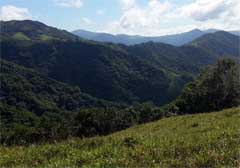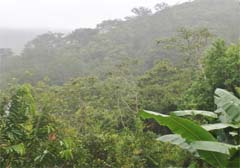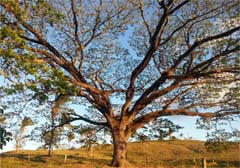Hojancheños - People Who Planted Trees
von 14 lubica
About four months ago, I arrived in a small town of Hojancha located in the Guanacaste province of Costa Rica. I took a bus from San José, not knowing any person, nor story about the place and arrived crossing many hills after the sunset in the middle of a forgotten valley. It seemed to be a well-hidden place surrounded by many hills and forests.
As I soon learnt, Hojancha got its name from an indigenous tree called hoja ancha Broadleaf because in the past, the tree (Cleidion castaneifolion) grew in abundance in the region and had very characteristic broad leaves.
The first couple of weeks, I didnt spot any hojancha trees and heard only from stories that with the arrival of many families and farmers from the central part of Costa Rica throughout the 20th century, who were using the wood for construction of ranches and houses, the hojancha trees almost disappeared from here, as often is the case in human-forest stories.

Hojancha Cradle of Reforestation in Costa Rica
The Governmental policies in 60s and 70s promoting cattle ranching and taxing forests as unproductive lands didnt help the situation. Farmers were encouraged to cut down trees and concentrate intensively on cattle production. Many Hojancheños still have a memory of forests turning into treeless pastures. When the beef prices dropped, Hojancha was confronted by many new challenges massive emigration of its population, increased deforestation, soil erosion, lack of employment and shrinking water volumes in the rivers.
The people responded with a strong community action. Already in the late 70s, they initiated local capacity trainings on leadership and created a Cantonal Agricultural Centre of Hojancha (CACH), which started to develop projects of reforestation, tree nurseries, demonstration plots and agroforestry. This marked the dawn of a new forest culture in Hojancha.

Monte Alto Reserve Community initiative to protect forests around water springs. Hard to imagine that 20 years ago this place was almost completely treeless
Chocolate Water in Dry Springs
People started working together for a new
vision of a green canton with healthy
environment and sustainable use of natural
resources. The protection of forests and
sustainable wood production were the two
key pillars of the new reforestation
strategy.
Despite the first achievements, the problem of water pollution and scarcity during the dry season persisted. Many described the Nosara River as chocolate water referring to cattle grazing around the spring. The community united for a new initiative; create a private foundation Monte Alto with the focus on reforesting the upper spring of Nosara and improving the water quality and management downstream. Moral and logistical support to the neighborhood of Monte Alto to restore forest cover around Nosara spring was also key principles of the new municipal strategy in early 90s.

Nowadays, Hojancha has around 40,6% of forest cover. Still many pastures that can be converted back to the forests if people continue planting trees
The Ministry of Environment and Energy (MINAE) supported the idea with co-management plan of sustainable use and protection of natural resources. Hojancheños chose a strategy of voluntary purchases of the land, without expropriation or forced participation. Drinking water scarcity was a true driver of local participation. People were donating land to the foundation and planting native tree species
In 1992 Monte Alto became a protected Forest Reserve. Since then people started massive reforestation, forest protection and created a rich secondary forests on the slopes around Nosara. It is an exceptional case of social action for environmental protection born of the water scarcity as an immediate response to a crisis faced by the whole community. Today Monte Alto is a green paradise, a center of tourism and environmental education and also a pride of Hojancheños when talking about its history and living the story of changing own consciousness and agricultural and forestry practices.
The local organization received also help from the outside. German based organization Tropica Verde, MINAE, and Municipality of Hojancha contributed to the creation of the foundation and participated in the process of purchasing land. The first land bought by the foundation had 7 hectares. Today the size of the protected area is around 924 ha from which 275 ha has an absolute protection as a natural forest.

Hojancha Paradise of Guanacaste, we maintain it clean, without plastic bags nor garbage
When I asked Hojancheños what were the key success factors of their change, many speak about a strong vision of canton different from others in Costa Rica. As a first thing, you need to plan well and create a clear strategy with goals and future vision about what you want to reach, secondly you need to train local leaders and empower all actors and the third important element is innovation and openness to learn new things along the path.
Indeed today Monte Alto is a rich forest and the place where I first saw hojancha trees growing again and slowly reappearing in the landscape. And the powerful story of Hojancheños who planted trees became a tradition deeply rooted in peoples hearts. It is now up to them to pass it to the future generations so they do not forget the values, forests provide to them.
 15-01-31 02:18:00,
15-01-31 02:18:00,
Neueste Kommentare